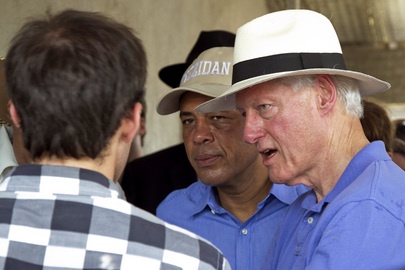
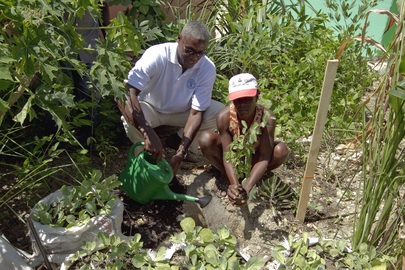
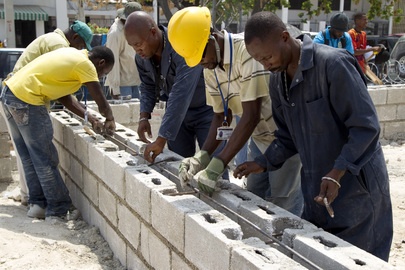
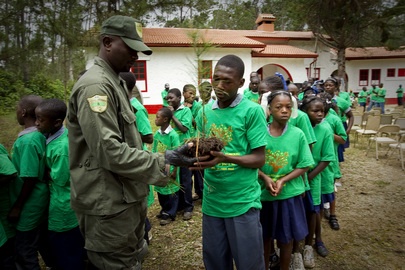
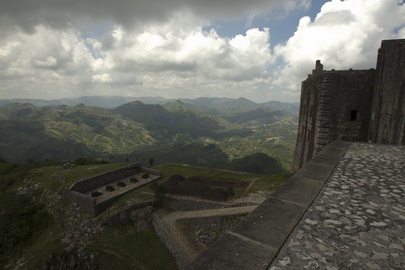
"There are a million people less in the camps than there were in July of 2010. Many of them have gone to new, what we call transitional houses. There's a 100,000 of these small dwellings being built. We also estimate there must be about 30,000 permanent houses that have been built or repaired," says Nigel Fischer, Resident and Humanitarian Coordinator of the United Nations System in Haiti.
According to the United Nations Development Programme (UNDP), 50 percent of debris has been removed, out of which 20 percent has been recycled. 500 “red houses” considered uninhabitable, have been demolished. Read: - “Haiti Cleans Up Rubble & Garbage” -
diplomaticallyincorrect.org/films/blog_post/haiti-cleans-up-rubble-garbage-by-ambassador-mo/43465
Integrity of Aid Funds Collected – New Infrastructure to Health Care:
Over $4.5 billion has been pledged to Haiti’s relief/reconstruction. Corruption and waste have been a concern for a country whose reputation is linked to such. However, the international officials overseeing distribution have great confidence that such problems have been avoided. The more pressing issue is how quickly such funds are deployed, (with just over a half disbursed for projects): "100 percent of the funds that were promised have been earmarked for programs, which means that they are not going to disappear. We know that they are there. About 53, 54percent have actually been disbursed to projects and the rest is waiting to be disbursed, but at least the money is not disappearing. And we are seeing, whether it is in terms of investment in the industrial zone in the North East of the country, in the hundreds of km of roads that have been paved, in the new housing starts, the increased numbers of children in schools compared to before the earthquake, or the investment in health-care. We are seeing in a number of fronts, we are seeing progress," according to Resident Coordinator Fischer
Haiti Institutions/Officials Increasingly Assuming Responsibility?
Approaching two years after the great earthquake, Haiti’s own institutions/officials are increasingly assuming responsibility. From disputed elections and delays in forming a new government to the death of Many Haiti’s bureaucrats and ongoing considerations regarding good governance, this transition has moved perhaps most slowly: "How do we start to transfer the functions, the programs that we are performing today to Haitian counterparts. What will we not be doing in 3 or 4 or 5 years that we are doing today? I think it is through building Haitian institutions at the end of the day that we will be able to see a lessening in numbers of International organizations that are here." See Film Report – Haiti Year Later – More to Do” -
diplomaticallyincorrect.org/films/movie/haiti-year-latermore-to-do/23964.
Rebuilding Transition from Relief:
Compared to a year earlier, notable progress can be seen. Rather than relief the conversation is much more about rebuilding and re-empowering Haiti. See from January 2011 “Haiti Economic Hope” -
diplomaticallyincorrect.org/films/movie/haiti-economic-hope/23599
More than 225,000 people were killed, more than 300,000 injured and 2, 3 million, almost one quarter of the population, displaced. Humanitarian assistance helped more than 4.3 million Haitians including temporary shelter for 1.5 million people. UN operations (MINUSTAH) also had to provide security in many areas as crime to sexual assault became a further curse particularly in Haiti’s urban areas and internally displaced people (IDP) camps. (See Film Report – “Sexual Violence in Haiti Camps” -
diplomaticallyincorrect.org/films/movie/sexual-violence-in-haiti-camps/24266 By UN Security Council Resolution, (2012) the UN has already initiated the reduction in military and police personnel.
By Ambassador Muhamed Sacirbey
Facebook – Become a Fan at “Diplomatically Incorrect”
Twitter – Follow us at DiplomaticallyX
“Haiti Emergency” Channel -
diplomaticallyincorrect.org/c/haiti-emergency
Above Photos include Bill Clinton, Carl Lewis and others participating in rebuilding effort, most importantly the Haitian people themselves. Bottom Photo: The impressive view from Citadelle Laferrière, a 200-year-old fortress built by King Henri-Christophe of Haiti, near Cap-Haïtien. The fortress, included in the World Heritage List of the UN Educational, Scientific, and Cultural Organization (UNESCO), is one of the stops made by Governor-General of Canada and UNESCO Special Envoy to Haiti, Michaëlle Jean, during her eight-day tour of historic and cultural sites in the country.









